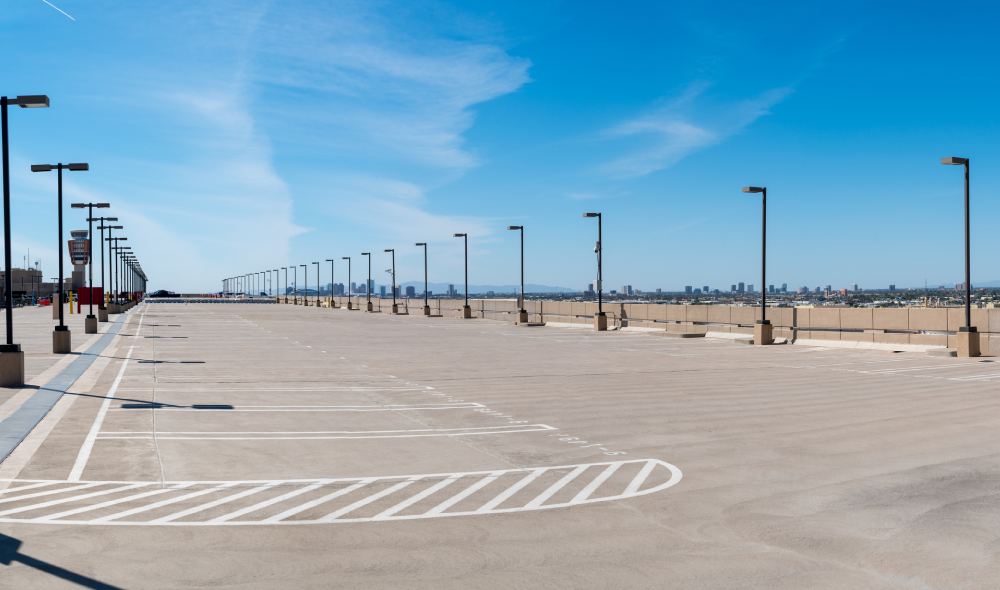
Valley of the Sun-Drenched Parking Space
Reducing urban heat could come down to parking reform
Most cities have little to no idea how many parking spaces they have. Nevertheless, we know that most cities have a lot of parking, and that most of it is free. This free parking comes with significant economic, environmental, and social costs. A city full of parking is a city designed for cars. When cities are designed for cars, car use becomes necessary, which makes drivers call for more car-oriented design, even though such design leads to more driving and pollution, and creates landscapes that hinder walking, biking and transit use.
For all these reasons, academics tend to think most cities have too much parking. Officials, however, often worry that they don’t have enough. Cities as a result enforce minimum parking requirements: zoning laws that require ample parking for nearly all buildings and land uses. The end result is automobile dependence masquerading as mobility freedom.
So, do cities have too much parking or too little? Answering that question requires good data. How much parking do cities actually have? Unfortunately, cities do not systematically inventory their spaces, and parking requirements are often inconsistent even across local municipalities. This makes it difficult to measure parking and evaluate related policy issues. Cities and researchers sometimes resort to manually counting spaces — a process that works for small areas like downtowns or business districts — and the results have been consistent: urban parking is oversupplied. Land use planning and policy are blindly expanding the supply of parking without any evidence that more parking is actually needed or how much parking even exists.
The importance of measuring the parking supply takes on new urgency when we consider climate change. Despite ample research on many impacts of abundant parking — on sustainable travel, urban design, and affordable housing, to name a few — researchers have to date paid little heed to its potentially significant consequences for urban heat.
Parking lots heat up in the sun and store solar energy, warming the local environment. Phoenix, where we work, regularly records asphalt surface temperatures in excess of 170 degrees Fahrenheit on summer afternoons. But this is not just a problem for desert cities. Continued global urbanization will intensify what are known as urban heat islands; situations where urban areas are warmer than rural areas due to built infrastructure (such as parking) and human activity (like driving).

Continued global urbanization will intensify what are known as urban heat islands; situations where urban areas are warmer than rural areas due to built infrastructure (such as parking) and human activity (like driving).

Urban heat islands, which are exacerbated by climate change, have increased both the severity and frequency of urban heat waves. Human health, urban productivity, and critical infrastructure systems are all threatened by extreme heat. Urban heat-related injuries and deaths are a growing concern around the globe. Extreme heat is dangerous to work in, and it discourages desirable outdoor activities like exercise, tourism, and travel. When heat rises, paved roads rut, water pumps are more likely to fail, and water quality declines as water pipes degrade. Energy use rises as demand for air conditioning increases, and water use rises as more water is lost to evaporation.
Heat islands are caused by human activity, especially activity that covers the natural landscape with paved surfaces such as asphalt and concrete. This fact suggests that parking requirements could be an engine of urban heat islands: the requirements force developers to make the city hotter. To date, however, researchers have not meaningfully investigated the connection between parking requirements, automobile dependence, and urban heat, in part because the parking supply is so hard to measure.
We tackled this problem by studying the metropolitan region of Phoenix, also known as the Valley of the Sun. Metro Phoenix is ideal for investigating the relationship between urban heat and urban parking. The region is saddled with many issues resulting from severe urban heat, including a rising number of heat-associated deaths over the last two decades. In each year from 2016 to 2018, metro Phoenix reported a record number of heat deaths, rising from 154 in 2016 to 182 in 2018. The metro is rapidly growing, sprawling, and car-dependent. In 2017, the region had more than 4 million residents, 2.9 million cars and 1.8 million jobs. Lastly, minimum parking requirements have the greatest impact on land use and car dependence in cities that have predominantly grown in the latter half of the 20th century, and this describes the Phoenix region well.
Metro Phoenix’s Current Parking Supply
We created a parking inventory for metro Phoenix by first combining, for 33 cities and towns in the Phoenix region, records of how property is used (e.g., office, retail, residence) with an inventory of minimum parking requirements for those uses (e.g., one space per unit for apartments). This allowed us to estimate how much off-street parking is required for each of the 1.6 million parcels of land in our sample. We then estimated the on-street parking supply by mapping the street network, adjusting for areas where parking would be prohibited (e.g., in front of driveways, in front of fire hydrants, within or near intersections, within tunnels, on bridges, and so on) and then dividing the remaining road length by the dimensions of a typical street space. We validated these results by manually counting more than 22,000 spaces.
Our results suggest that as of 2017, metro Phoenix had about 12.2 million parking spaces. There are 3.7 million off-street residential spaces, 3.6 million off-street non-residential spaces, and 4.9 million on-street spaces. This equates to approximately 4.3 spaces per vehicle, 3.0 spaces per person, and 6.6 spaces per job. The entire metropolitan region of Phoenix has a parking density of approximately 39 spaces per hectare (16 per acre). Put another way, approximately 10 percent of the region’s land area is dedicated to parking.
Residential parking (on- and off-street) accounts for 69 percent of total spaces, and off-street parking (residential and non-residential) accounts for 60 percent of total spaces. Figure 1 compares the on- and off-street parking density in metro Phoenix, while Figure 2 compares residential and non-residential parking density. Parking supply in residential areas is high: all municipalities in metro Phoenix require at least two off-street parking spaces for every single-family home — even when on-street space nearby is plentiful — and over two-thirds of urban properties are single-family homes. Parking density is highest around high-density travel corridors and within downtown districts; Downtown Scottsdale has the highest density of parking, with 127 spaces per hectare, compared to downtown Tempe (113) and downtown Phoenix (112).
Figure 1. On and off-street parking density in metro Phoenix
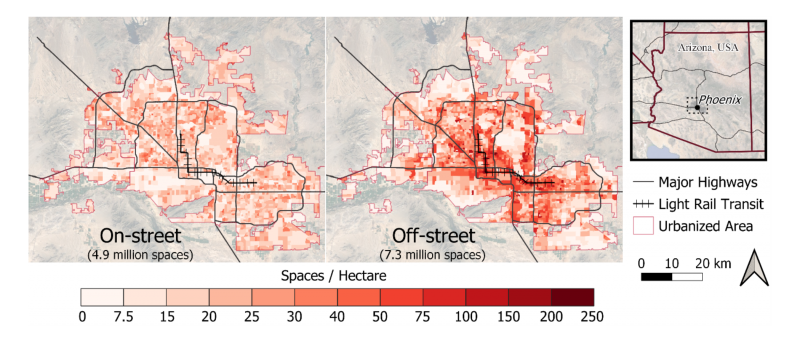
Figure 2. Residential and non-residential parking density in metro Phoenix
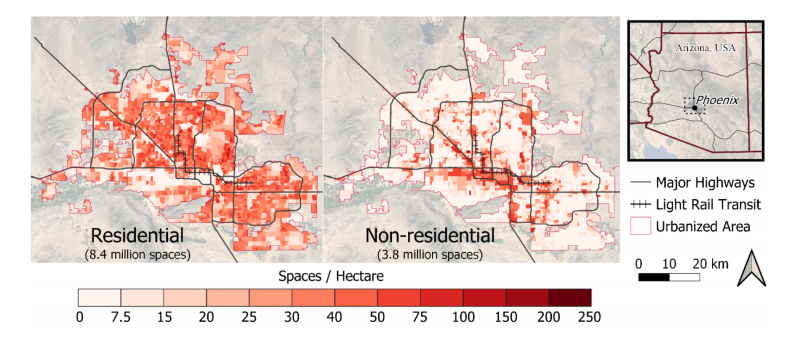
Historical Metro Phoenix Parking Growth
Metro Phoenix added most of its parking supply between the end of World War II and the Great Recession of 2008. Starting in the mid-20th century, parking supply grew rapidly, but after the 2008 recession, the growth significantly slowed. Before 1960, metro Phoenix had less than one off-street parking space per resident, and the majority of available parking was on-street. Since 1960, metro Phoenix has seen an increase of nearly 11 million parking spaces, 3.4 million residents, 2.6 million vehicles, and 1.6 million jobs. From 1960 until 2000, parking availability in metro Phoenix grew by 5.2 percent per year compared to population growth of 4.1 percent per year. In recent years, parking growth has significantly slowed down to less than 1 percent per year. This recent decline is directly linked to the 2008 recession’s slowing of new property development. When parking is provided primarily through mandates on new development, less development means less new parking.
Figure 3. The historical growth of parking in metro Phoenix
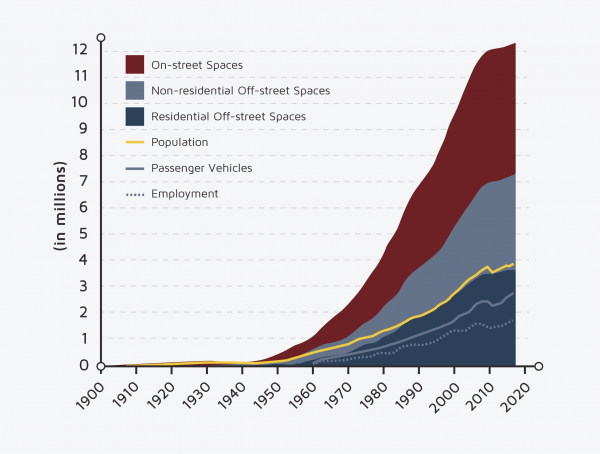
A Tale of Two Cities
Phoenix is often compared to Los Angeles. Both regions are products of postwar development booms, with the main differences being Phoenix’s lack of land constraints (it has neither oceans nor mountains) and its boom beginning several decades after Los Angeles. As a result, Los Angeles is further along in dealing with issues related to parking and car dependence. When comparing parking in Phoenix to Los Angeles, some interesting differences arise (note: we compare Los Angeles in 2010 to metro Phoenix in 2017).
Los Angeles County had more parking spaces (18.6 million vs. 12.2 million) and a higher density of land dedicated to parking (14% vs. 10%), but metro Phoenix had more parking spaces per car (4.3 vs. 3.3 spaces). Metro Phoenix also has more spaces per job (6.6 vs. 4.7).
Despite the greater overall parking supply and density in Los Angeles County, metro Phoenix has 36 percent more on-street parking spaces, largely driven by increased residential street parking. To explore the cause, we compared the two regions in metrics of density (and zoomed into urbanized Los Angeles County here), finding Los Angeles denser by nearly all metrics. The two regions have nearly identical roadway densities but in Los Angeles there is a more connected road network and a higher density of buildings. As a result, we conclude there is less street space available for parking per mile of road in Los Angeles (basically, there are more obstructions to curb space from intersections and driveways). Despite the higher availability of curbside parking in metro Phoenix, Los Angeles likely has much higher utilization of and cruising for on-street parking due to higher demand and lower supply.
Figure 4. Parking, jobs, people and vehicles in Los Angeles County and metro Phoenix
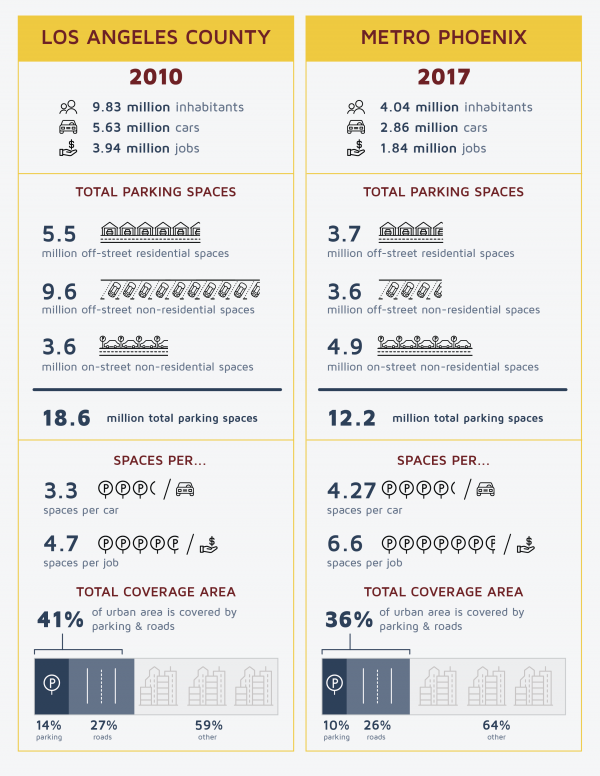
Urban Heat Consequences of Parking and Auto-Dependence
Using the newly generated parking inventory data in combination with vehicle travel data and road network data, we evaluated the heat emitted from parking, roadways, and cars in metro Phoenix. A large body of research has previously examined urban heat effects from buildings, vehicles, and humans (we give off heat too!). In these studies, buildings are the primary culprit, vehicles are marginal contributors overall (but can be significant in some contexts, especially near highways), and human metabolic heat is usually inconsequential. However, almost no research had quantified the citywide impacts from pavement.
We find that, in hot, sprawling, and car-dependent metro Phoenix, all the paved parking lots, abundant roads, and 2.6 million vehicles combine to contribute significant amounts of heat to their surroundings. By our estimate, Phoenix’s parking infrastructure accounts for roughly 29 percent of the region’s total heat emitted from pavements and vehicles on a typical day (roads contribute to 67 percent of the total, vehicles 4 percent). Heat emitted from pavement is most intense during summer afternoons; at these times, pavement radiates 46 percent more heat than the natural landscape. We know from other research that while buildings, cars, and people also contribute substantially to urban heat, the heat from these sources often peaks outside the summer months. As a result, the high coverage of parking and roadway pavement may be the most significant urban design contributor exacerbating extreme summer heat. Therefore, reducing the urban parking oversupply (and pavement overall) may help reduce severe urban heat.
Figure 5. Percent of urban heat emitted from pavement and vehicles
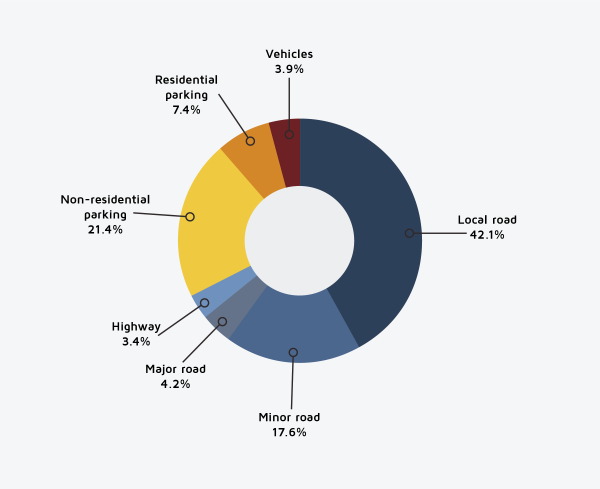
Towards Auto-Independence and Cooler Cities
What can cities do to reduce the heat impacts of so much parking? Parking lots are often paved with asphalt, so one way to reduce their heat effect is to increase the albedo, or reflectivity, of the pavement. Doing so makes the pavement reflect more solar radiation and absorb less of it, which results in cooler pavements and cooler nearby air temperatures. Albedo can be increased through methods like whitetopping (covering an existing asphalt pavement with a layer of highly reflective concrete). Whitetopping has one major drawback, however: even though the surroundings will ultimately be cooler, during the day, pedestrians traversing a more reflective pavement will often feel hotter because they are exposed to additional radiation being reflected off the pavement beneath their feet (without whitetopping, that radiation would have been stored in the pavement, warming its surroundings over time). This heat effect is particularly acute during summertime afternoons when incoming solar radiation is at its peak, and when improving thermal comfort for pedestrians is most crucial.
Another common strategy to reduce heat through design is to increase the amount of shade, with more structures or trees. Yet this strategy is less viable than it might first seem. Parking lot pavement makes the temperature of surrounding soil rise, and accelerates evaporation. Any nearby trees thus need more water than usual, making it more difficult to keep them healthy. This challenge is especially problematic in hot climates, both because pavement’s impact on soil temperature increases as air temperatures rise, and because many hot places, like Phoenix, already face constraints on their water use.
A similar suggestion is to cover parking lots with solar panels, which can provide shade in addition to their primary purpose of providing electricity. But solar panels absorb heat, and also have low reflectivity. Adding panels thus means adding an additional surface that partially absorbs and slowly radiates heat, leading to a greater amount of heat that can become trapped. A recent study of solar installations over asphalt parking lots in Phoenix found that, for precisely this reason, they might actually warm the local environment. Other research, however, has found the opposite, so this question warrants more scrutiny. And none of this is to suggest that shading is useless; pedestrians are shielded from direct sunlight while in the shade. It does suggest, however, that the best approach for cities might be to reduce urban pavement coverage — have less paved area to begin with — rather than mitigating pavement once it is there, with steps like whitetopping or tree planting.
Reducing paved area means reducing surface parking. Given the abundance of parking in metro Phoenix, planners and policymakers should reform minimum requirements, and provide opportunities for both improved parking management and parking space repurposing. Doing so would not make it meaningfully more difficult to park, and could pay substantial environmental and social dividends. At a minimum, parking requirements should reflect the large number of current parking spaces, and should more aggressively promote opportunities to share existing spaces. Phoenix could reform or remove residential parking requirements. Buffalo, Minneapolis, and San Francisco have already removed all off-street parking requirements. Identifying current and future areas where excess parking could be repurposed into greenspace, affordable housing, or other beneficial urban land uses will become an increasingly valuable strategy, especially since changing standards for new development will not immediately affect the oversupply of parking that already exists.

Identifying current and future areas where excess parking could be repurposed into greenspace, affordable housing, or other beneficial urban land uses will become an increasingly valuable strategy.

The high urban pavement coverage needed to serve automobiles is likely the most significant urban driver of increased urban heat. Therefore, reducing car dependence — through not just reformed parking standards but also planning for increased urban density — could be an effective way to alleviate urban heat. Increasing urban density can reduce the frequency and distance of car trips. It can also make parking and road infrastructure less necessary, by putting destinations closer to each other and making public and active transit more effective, meaning fewer trips need to be by car. Zoning for increased building density can also improve what designers call street canyon shading — more buildings that are closer together and closer to the street can provide more shade on streets and sidewalks. Greater shade also makes walking more comfortable during hot periods. Sprawling urban design has been linked to more extreme heat events, likely driven by sprawling pavement coverage, and is yet another reason for planners and policymakers to focus on compact urban design over sprawl.
The amount of infrastructure devoted to automobiles is large and has devastating effects on cities. We have long known that parking requirements encourage and subsidize driving. This research is part of a growing body of literature that documents the problems caused by reserving so much space for driving and parking. Now we can add local climate effects to that list of problems. Phoenix’s 12 million parking spaces capture the sun’s energy and cook the city even more than the desert climate already does.